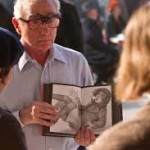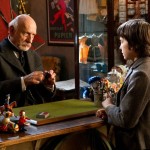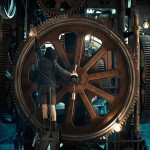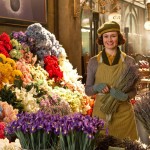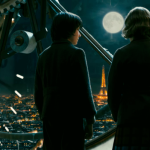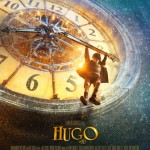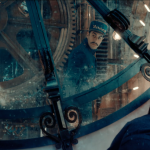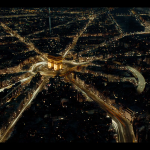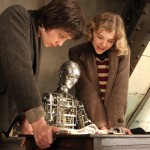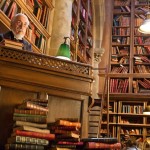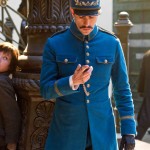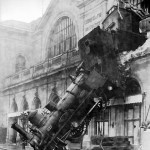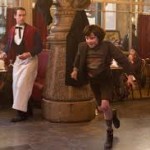Scorcese is the man who makes mob movies oozing with bad words, brutality and blood spillage. That’s what he’s good at – the likes of Goodfellas, The Departed, Raging Bull, Gangs of New York, even that epic homage to excess, The Wolf of Wall Street – that’s Scorcese, right?
Well yes to all of the above, but here’s the exception that proves the rule: Hugo is a sharp, enchanting, funny, intelligent, clever and inventive movie that will win over adults every bit as much as kids, adapted by Brian Selznick‘s highly graphical novel The Invention of Hugo Cabret. Selznick, being by trade primarily an illustrator, provides many pictures as a starting point on the look and feel of the movie.
And guess what – not a drop of blood to be seen nor an expletive to be heard, still less any wise guys trampling the charm. It brings together some splendid acting from a mega cast, including two excellent teenage veterans (Asa Butterfield and Chloë Grace Moretz), a superbly realised production design.
But all this would be as nothing were it not for the deft touch of Martin the master craftsman pulling the strings, for which his efforts were duly rewarded. Wikipedia:
The film was received with critical acclaim, with many critics praising the visuals, acting, and direction. At the 84th Academy Awards, Hugo won five Oscars — for Best Cinematography, Best Art Direction, Best Visual Effects, Best Sound Mixing, and Best Sound Editing—and its eleven total nominations (including Best Picture) was the most for the evening. Hugo was also nominated for eight BAFTAs and won two, and was nominated for three Golden Globe Awards, earning Scorsese his third Golden Globe Award for Best Director.
Clearly the director was entranced by the pictures as much as the narrative, since he has created a beautiful replica of 1931 Paris, the old-fashioned splendour of mechanical automatons and the magic of the early movies – as perfect a combination of ingredients as contained by any movie I’ve seen in some while. Some of the vintage images recreated or incorporated here are among the most iconic and memorable: Paris itself, the train crash at Montparnasse, the man in the moon and other great moments of the movies of Georges Méliès, portrayed here in old age by the ever dependable Sir Ben Kingsley (and never forget his knighthood!)
In fact the cast does a pretty excellent job in rising to the challenge, though I do wish Sacha Baron Cohen would stop doing silly voices and focus on core acting skills – of which, when he tries, he is quite capable. I love the charming cameos from Helen McCrory and Sir Christopher Lee in particular, but then there are so many delightful goodies on display in Scorcese’s sweet shop it’s very easy to be blinded by choice.
The story is in essence very simple, though as I will go on to discuss the realisation is infinitely complex. The hero, Hugo, lives alone in the old Gare Montparnasse, some decades prior to its complete rebuilding. Tell you what, let’s copy the Wikipedia summary:
In 1931, Hugo Cabret, a 12-year-old boy, lives with his father, a widowed, but kind and devoted master clockmaker in Paris. Hugo’s father takes him to see films and loves the films of Georges Méliès best of all. Hugo’s father is burned alive in a museum fire, and Hugo is taken away by his uncle, an alcoholic watchmaker who is responsible for maintaining the clocks in the railway station of Gare Montparnasse. His uncle teaches him to take care of the clocks, then disappears. Hugo lives between the walls of the station, maintaining the clocks, stealing food and working on his father’s most ambitious project: repairing a broken automaton – a mechanical man who is supposed to write with a pen. Hugo steals mechanical parts in the station to repair the automaton, but he is caught by a toy store owner who takes away Hugo’s blueprints for the automaton. The automaton is missing one part – a heart–shaped key. Convinced that the automaton contains a message from his father, Hugo goes to desperate lengths to fix the machine. He gains the assistance of Isabelle, a girl close to his age and the goddaughter of the toy shop owner. He introduces Isabelle to the movies, which her godfather has never let her see. Isabelle turns out to have the key to the automaton. When they use the key to activate the automaton, it produces a drawing of a film scene Hugo remembers his father telling him about. They discover that the film was created by Georges Méliès, Isabelle’s godfather, an early – but now neglected and disillusioned – cinema legend, and that the automaton was a beloved creation of his, from his days as a magician. In the end, the children reconnect Georges with his past and with a new generation of cinema aficionados who have come to appreciate his work.
While some have criticised the sprawling scope of Scorcese’s work, a factor common to many of his movies and within the gift of very few film makers to make such a wide purview stick together, his attention to detail is loving – his movie looks ravishing throughout, though as a story it has bite too. The corollary of that perceived failing is that the movies go on longer than the attention span and, as Hitchcock famously put it, the bladder capacity of its audience. Hugo is a tad over 2 hours, which by Scorcese standards is barely getting going, though some of the younger members of the audience would find this U certificate movie uncomfortably long.
Then there is the 3D, used for the original cinematic release but clearly not for 2D television, which is where I caught up with Hugo. Scorcese said this of the gimmick:
“I found 3D to be really interesting, because the actors were more upfront emotionally. Their slightest move, their slightest intention is picked up much more precisely.”
I’m far from convinced, though in mitigation it’s evident from the 2D version he did not go overboard in producing flashy effects for the benefit of 3D viewers, other maybe than the climax with young Hugo dangling from the station clock. However, peers and critics were kind on this point:
Richard Corliss of Time named it one of the Top 10 Best Movies of 2011, saying “Scorsese’s love poem, rendered gorgeously in 3-D, restores both the reputation of an early pioneer and the glory of movie history – the birth of a popular art form given new life through a master’s application of the coolest new techniques”. James Cameron called Hugo “a masterpiece” and that the film had the best use of 3D he had seen, surpassing even his own acclaimed films
However, audiences were far from convinced:
Hugo earned $73,864,507 domestically and $111,905,653 internationally for a worldwide gross of $185,770,160. Hugo was cited as one of the year’s notable box office flops despite garnering praise from critics. The film gained $15.4 million over the Thanksgiving weekend and almost $74 million domestically, barely half of its $170 million budget, even though it made strength overseas. Hugo’s perceived failure was due to competition with Disney’s The Muppets and Summit’s Breaking Dawn Part 1. The film is set to cost its studio $100 million because of its box office performance. Producer Graham King expressed that the film’s box office results have been painful. “There’s no finger pointing — I’m the producer and I take the responsibility,” he said glumly. “Budget wise, there just wasn’t enough prep time and no one really realised how complicated doing a 3-D film was going to be. I went through three line producers because no one knew exactly what was going on. Do I still think it’s a masterpiece that will be talked about in 20 years? Yes. But once the schedule started getting out of whack, things just spiralled and spiralled and that’s when the avalanche began.”
So in other words, the movie became a victim of Scorcese’s ingenuity and scope. In many ways this is a shame, because, as with all the best effects, you should barely be aware of the complexity – the story will enthral you. However, I would love someday to see the master attempt a very simple story with few actors and sets, then just focus on human values and emotions. Maybe making that scenario come to life will be his biggest test yet?


